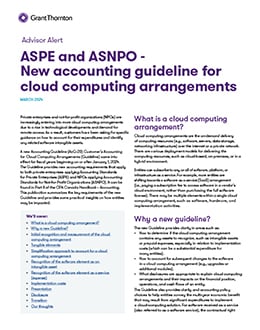-
Financial reporting and accounting advisory services
You trust your external auditor to deliver not only a high-quality, independent audit of your financial statements but to provide a range of support, including assessing material risks, evaluating internal controls and raising awareness around new and amended accounting standards.
-
Accounting Standards for Private Enterprises
Get the clear financial picture you need with the accounting standards team at Doane Grant Thornton LLP. Our experts have extensive experience with private enterprises of all sizes in all industries, an in-depth knowledge of today’s accounting standards, and are directly involved in the standard-setting process.
-
International Financial Reporting Standards
Whether you are already using IFRS or considering a transition to this global framework, Doane Grant Thornton LLP’s accounting standards team is here to help.
-
Accounting Standards for Not-for-Profit Organizations
From small, community organizations to large, national charities, you can count on Doane Grant Thornton LLP’s accounting standards team for in-depth knowledge and trusted advice.
-
Public Sector Accounting Standards
Working for a public-sector organization comes with a unique set of requirements for accounting and financial reporting. Doane Grant Thornton LLP’s accounting standards team has the practical, public-sector experience and in-depth knowledge you need.
-
Tax planning and compliance
Whether you are a private or public organization, your goal is to manage the critical aspects of tax compliance, and achieve the most effective results. At Doane Grant Thornton, we focus on delivering relevant advice, and providing an integrated planning approach to help you fulfill compliance obligations.
-
Research and development and government incentives
Are you developing innovative processes or products, undertaking experimentation or solving technological problems? If so, you may qualify to claim SR&ED tax credits. This Canadian federal government initiative is designed to encourage and support innovation in Canada. Our R&D professionals are a highly-trained, diverse team of practitioners that are engineers, scientists and specialized accountants.
-
Indirect tax
Keeping track of changes and developments in GST/HST, Quebec sales tax and other provincial sales taxes across Canada, can be a full-time job. The consequences for failing to adequately manage your organization’s sales tax obligations can be significant - from assessments, to forgone recoveries and cash flow implications, to customer or reputational risk.
-
US corporate tax
The United States has a very complex and regulated tax environment, that may undergo significant changes. Cross-border tax issues could become even more challenging for Canadian businesses looking for growth and prosperity in the biggest economy in the world.
-
Cross-border personal tax
In an increasingly flexible world, moving across the border may be more viable for Canadians and Americans; however, relocating may also have complex tax implications.
-
International tax
While there is great opportunity for businesses looking to expand globally, organizations are under increasing tax scrutiny. Regardless of your company’s size and level of international involvement—whether you’re working abroad, investing, buying and selling, borrowing or manufacturing—doing business beyond Canada’s borders comes with its fair share of tax risks.
-
Succession & estate planning
Like many private business owners today, you’ve spent your career building and running your business successfully. Now you’re faced with deciding on a successor—a successor who may or may not want your direct involvement and share your vision.
-
Tax Reporting & Advisory
The financial and tax reporting obligations of public markets and global tax authorities take significant resources and investment to manage. This requires calculating global tax provision estimates under US GAAP, IFRS, and other frameworks, and reconciling this reporting with tax compliance obligations.
-
Transfer pricing
Recognized as a leader in the transfer pricing community, our award-winning team can help you expand your business beyond borders with confidence.

-
Transactions
Our transactions group takes a client-centric, integrated approach, focused on helping you make and implement the best financial strategies. We offer meaningful, actionable and holistic advice to allow you to create value, manage risks and seize opportunities. It’s what we do best: help great organizations like yours grow and thrive.
-
Restructuring
We bring a wide range of services to both individuals and businesses – including shareholders, executives, directors, lenders, creditors and other advisors who are dealing with a corporation experiencing financial challenges.
-
Forensics
Market-driven expertise in investigation, dispute resolution and digital forensics
-
Cybersecurity
Viruses. Phishing. Malware infections. Malpractice by employees. Espionage. Data ransom and theft. Fraud. Cybercrime is now a leading risk to all businesses.
-
Consulting
Running a business is challenging and you need advice you can rely on at anytime you need it. Our team dives deep into your issues, looking holistically at your organization to understand your people, processes, and systems needs at the root of your pain points. The intersection of these three things is critical to develop the solutions you need today.
-
Creditor updates
Updates for creditors, limited partners, investors and shareholders.

-
Governance, risk and compliance
Effective, risk management—including governance and regulatory compliance—can lead to tangible, long-term business improvements. And be a source of significant competitive advantage.
-
Internal audit
Organizations thrive when they are constantly innovating, improving or creating new services and products and envisioning new markets and growth opportunities.
-
Certification – SOX
The corporate governance landscape is challenging at the best of times for public companies and their subsidiaries in Canada, the United States and around the world.
-
Third party assurance
Naturally, clients and stakeholders want reassurance that there are appropriate controls and safeguards over the data and processes being used to service their business. It’s critical.
-
 Assurance Important changes coming to AgriInvest in 2025AgriInvest is a business risk management program that helps agricultural producers manage small income declines and improve market income.
Assurance Important changes coming to AgriInvest in 2025AgriInvest is a business risk management program that helps agricultural producers manage small income declines and improve market income. -
 Tax alert Agricultural Clean Technology ProgramThe Agricultural Clean Technology Program will provide financial assistance to farmers and agri-businesses to help them reduce greenhouse gas (GHG) emissions.
Tax alert Agricultural Clean Technology ProgramThe Agricultural Clean Technology Program will provide financial assistance to farmers and agri-businesses to help them reduce greenhouse gas (GHG) emissions. -
 Tax alert ACT Program – Research and Innovation Stream explainedThe ACT Research and Innovation Stream provides financial support to organizations engaged in pre-market innovation.
Tax alert ACT Program – Research and Innovation Stream explainedThe ACT Research and Innovation Stream provides financial support to organizations engaged in pre-market innovation. -
 Tax alert ACT Program – Adoption Stream explainedThe ACT Adoption Stream provides non-repayable funding to help farmers and agri-business with the purchase and installation of clean technologies.
Tax alert ACT Program – Adoption Stream explainedThe ACT Adoption Stream provides non-repayable funding to help farmers and agri-business with the purchase and installation of clean technologies.
-
Builders And Developers
Every real estate project starts with a vision. We help builders and developers solidify that vision, transform it into reality, and create value.
-
Rental Property Owners And Occupiers
In today’s economic climate, it’s more important than ever to have a strong advisory partner on your side.
-
Real Estate Service Providers
Your company plays a key role in the success of landlords, investors and owners, but who is doing the same for you?

-
Mining
There’s no business quite like mining. It’s volatile, risky and complex – but the potential pay-off is huge. You’re not afraid of a challenge: the key is finding the right balance between risk and reward. Whether you’re a junior prospector, a senior producer, or somewhere in between, we’ll work with you to explore, discover and extract value at every stage of the mining process.
-
Oil & gas
The oil and gas industry is facing many complex challenges, beyond the price of oil. These include environmental issues, access to markets, growing competition from alternative energy sources and international markets, and a rapidly changing regulatory landscape, to name but a few.

A new Accounting Guideline (AcG-20) Customer’s Accounting for Cloud Computing Arrangements (Guideline) came into effect for fiscal years beginning on or after January 1, 2024. The Guideline provides new accounting requirements that apply to both private enterprises applying Accounting Standards for Private Enterprises (ASPE) and NPOs applying Accounting Standards for Not-for-Profit Organizations (ASNPO). It can be found in Part II of the CPA Canada Handbook – Accounting. This publication summarizes the key requirements of the new Guideline and provides some practical insights on how entities may be impacted.
What is a cloud computing arrangement?
Cloud computing arrangements are the on-demand delivery of computing resources (e.g., software, servers, data storage, networking infrastructure) over the internet or a private network. There are various deployment models for delivering the computing resources, such as cloud-based, on-premises, or in a hybrid environment.
Entities can subscribe to any or all of software, platform, or infrastructure as a service. For example, more entities are shifting towards a software as a service (SaaS) arrangement (i.e., paying a subscription fee to access software in a vendor’s cloud environment, rather than purchasing the full software license). There may be multiple elements within a single cloud computing arrangement, such as software, hardware, and implementation activities.
Why a new Guideline?
The new Guideline provides clarity in areas such as:
- How to determine if the cloud computing arrangement contains any assets to recognize, such as intangible assets or prepaid expenses, especially in relation to implementation costs (which can be a substantial expenditure for many entities).
- How to account for subsequent changes to the software in a cloud computing arrangement (e.g., upgrades or additional modules).
- What disclosures are appropriate to explain cloud computing arrangements and their impacts on the financial position, operations, and cash flows of an entity.
The Guideline also provides clarity and accounting policy choices to help entities convey the multi-year economic benefit that may result from significant expenditures to implement a cloud-computing solution. For software received as a service (also referred to as a software service), the contractual right obtained by the entity is often the right to access the vendor’s software, rather than the right to control the vendor’s software itself. As a result, many entities had difficulty achieving asset treatment for any implementation costs incurred related to the software service, resulting in those costs being expensed.
Initial recognition and measurement of the cloud computing arrangement
At inception of the cloud computing arrangement, the entity (or “customer”) must allocate the consideration to its significant separable elements (e.g., hardware, licensing the software/subscription to access the software, and in some cases, implementation activities). Factors to consider when determining whether a software element is separable from the implementation activities include whether:
- the vendor sells the software license/subscription to other customers separately from the implementation activities, or
- only the vendor or the vendor’s subcontractor is capable of performing the implementation activities.
The entity must allocate the consideration to the various significant separable elements on a rational and consistent basis. While the Guideline doesn’t prescribe an allocation method, entities can look to the suggested methods in Section 3400 Revenue.
Tangible elements
The Guideline doesn’t address the accounting for tangible elements in a cloud computing arrangement, such as expenditures on property, plant and equipment or a right to use a tangible capital asset. Entities should refer to Section 3061 Property, plant and equipment / Section 4433 Tangible capital assets held by not-for-profit organizations or Section 3065 Leases, as appropriate.
Simplification approach to account for a cloud computing arrangement
Entities can use a simplification approach to account for expenditures in a cloud computing arrangement (other than tangible elements). In this approach, expenditures are treated as the supply of services and expensed as incurred. A prepayment for the delivery of the service would be recognized as an asset (i.e., prepaid expense), if an advance payment has been made.
The simplification approach is an accounting policy choice that must be applied consistently to expenditures in all cloud computing arrangements. It’s not an arrangement-by-arrangement choice. An entity that doesn’t apply this approach must determine if a software element is a software intangible asset or a software service (see next section).
Practical insightThe simplification approach reduces accounting complexity and cost, as the entity doesn’t have to:
|
Recognition of the software element as an intangible asset
Entities that don’t elect the simplification approach must assess whether there’s a software element that must be recognized as an intangible asset. For this assessment, the entity would refer to the guidance in Section 3064 Goodwill and intangible assets which requires the recognition of an intangible asset for an element that:
- is identifiable
- is controlled by the entity, and
- has future economic benefits that flow to the entity.
A software element is generally identifiable because it arises from contractual rights, and would have future economic benefits that flow to the entity from the use of the software. For the second criterion, the Guideline, conveys that a software element is controlled by the entity if it meets both of the following conditions:
- it has the contractual right to obtain the software without significant penalty (i.e., the ability to take delivery of the software without incurring significant cost), and
- it can use the software separately without a significant reduction in utility/value and it is feasible for the entity to run the software on its own or on a third party's infrastructure.
The entity may control the software element based on other factors such as, but not limited to:
- exclusive rights to use the software or ownership of the intellectual property for customized software (i.e., the vendor cannot make the software available to other customers), or
- decision-making rights to change how and for what purpose the software is used throughout the period of use (e.g., the entity can decide on how and when to update or reconfigure the software).
Recognition of the software element as a service (expense)
For a software element in the arrangement that doesn’t meet the definition of an intangible asset, it’s accounted for as a service (also referred to as a “software service”). When an entity pays a subscription fee to access software which doesn’t meet the definition of an intangible asset, the consideration allocated to the software service must be expensed as incurred.
Implementation costs
Many entities incur substantial implementation costs as part of their cloud computing arrangements. For example, entities may incur integration, customization or coding, configuration, data conversion, testing, training, and/or business process reengineering expenditures.
For entities that elect the simplification approach, expenditures in a cloud computing arrangement (other than tangible elements) are expensed as incurred, which includes implementation costs. Entities that do not elect the simplification approach the new Guideline provides entities with an accounting policy choice to either capitalize or expense certain implementation costs related to a software service. This accounting policy choice must be applied consistently to the software services in all of the entity’s cloud computing arrangements.
Implementation costs related to other elements in the arrangement may still need to be expensed or capitalized depending on their nature.
Accounting treatment for implementation costs when an entity does not elect the simplification approach
An entity may incur subsequent expenditures to enhance the service potential of the software after the initial implementation of the software element. Service potential may be enhanced when there is an increase in the previously assessed service capacity, an extension of the useful life or the expected period of access to the software service, or an improvement in the quality of the output. When this occurs, the expenditures that are directly attributable to enhancing the service potential of:
- a software intangible asset— are added to the carrying amount of the software intangible asset
- a software service— are included in the carrying amount of any implementation cost asset that was recognized (see item 3b in the previous table). Maintenance activities must be expensed as incurred.
Presentation
Entities must present any software intangible assets, along with any directly attributable expenditures on implementation activities, in accordance with Section 3064 Goodwill and intangible assets. The cash flows are classified under investing activities in the statement of cash flows.
Implementation costs associated with software services that the entity has elected to capitalize as an asset must be presented as a separate asset on the balance sheet. Generally, this asset is presented as a long-term asset, unless the expected term of access to the software service is less than one year from the balance sheet date, or within the normal operating cycle of the entity (when it is more than a year). The expensing of the implementation costs asset is included in the same line item in the income statement as the subscription fees expense for the software service. The cash flows are classified as operating activities in the statement of cash flows.
Disclosure
An entity that applies the simplification approach must disclose that fact, the amount expensed for the period, and where it was included in the income statement.
An entity that doesn’t apply the simplification approach must disclose the following for a software service:
- The amount expensed for the period and where it is included in the income statement;
- The policy followed to account for expenditures that are directly attributable to implementing the software service;
- If implementation expenditures directly attributable to a software service are capitalized, the net carrying amount capitalized and the method used to expense the amount, including the expected period of access to the software service by the entity; and
- For any impairment loss recognized, the amount of the impairment loss, where the impairment loss is included in the income statement, and the facts and circumstances leading to the impairment.
The entity would also need to disclose any commitments in accordance with Section 3280 Contractual obligations.
Transition
The Guideline applies to fiscal years beginning on or after January 1, 2024, with earlier application permitted. A choice must be made to apply the standard either retrospectively or retrospectively only to expenditures on implementation activities incurred in a cloud computing arrangement on or after the beginning of the earliest period presented in the financial statements in which the entity first applies the Guideline. If the entity applies this transitional provision, it must disclose that fact. It’s also required to apply the Guideline retrospectively to any previously recognized assets resulting from a cloud computing arrangement with any adjustment to those assets recorded in opening retained earnings of the earliest period presented.
Our thoughts
This new Guideline clarifies the accounting, especially related to implementation costs, for entities that enter into cloud computing arrangements. For entities that want to reduce their accounting costs and burden, they should elect the simplification approach. For entities that wish to better convey the future benefits provided by their expenditures, they can opt not to elect the simplification approach, capitalize any intangible assets, and choose to capitalize certain implementation costs to better convey the expected period of benefit in their income statement. These accounting policy choices must be applied consistently to all of the entity’s cloud computing arrangements.
How can Grant Thornton help?
At Grant Thornton, our advisors are up to date on AcG-20 and can help enterprises interpret the guidance, assess the impact on their financial statements and determine what information the enterprise needs to gather in advance of applying the new requirements for the first time. Please reach out to your Grant Thornton advisor if you have any questions.
Disclaimer
The information contained herein is general in nature and is based on proposals that are subject to change. It is not, and should not be construed as, accounting, legal or tax advice or an opinion provided by Doane Grant Thornton LLP to the reader. This material may not be applicable to, or suitable for, specific circumstances or needs and may require consideration of other factors not described herein.
